In 1880, Hannah James (27 years old) was living with her children, Liza (10), William (7), Elisha (6), Mariah (3), Elizabeth (1), and James (an infant), plus Nancy Davis (12), in Liberty County, Georgia[1].
Who were Hannah’s parents? Hannah would have been about 17, but there was no Hannah James or Hannah Davis in the 1870 Liberty County census.
An easy way to find a mother’s maiden name in Georgia is to look for children who died after 1918-ish, when death certificates became common and they can be found online. Hannah’s son Elisha/Elijah James died on August 30, 1984[2].
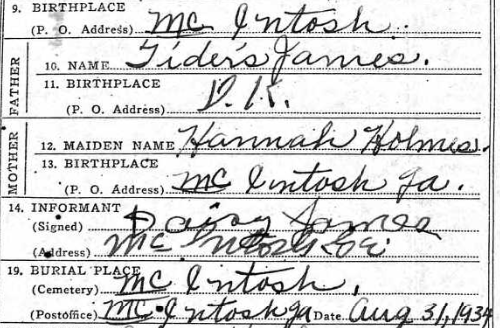
Elisha James’ death certificate (Ancestry.com)
“McIntosh” is not McIntosh County, Georgia; it is a place in Liberty County. This certificate listed “Tider’s James,” birthplace unknown for Elisha’s father, and “Hannah Holmes” for his mother.
The name “Tider’s” is odd, and probably what the official heard; it is possibly a misspelling of Titus. Unfortunately, nothing further was found about Elisha’s father during this study.
Hannah Holmes was a different matter. Using the information from this death certificate, it proved possible to trace Hannah Holmes back to her grandparents through several different enslavers.
In 1870, a 16-year-old Hannah Holmes was in the household of her Holmes parents.[3] Her mother’s name was Rose, 57 years old, and her father’s name was…hard to read. It was indexed as Shael, and it is easy to see why the indexer chose that, but it also could have been Shuel. He was said to be born in 1810. Their children were Hannah (16), Henrietta (13), Bob (11), George (9), Nancy (2), and Edward (1). Was Nancy the 12-year-old Nancy Davis in the 1880 census? It certainly seems likely.
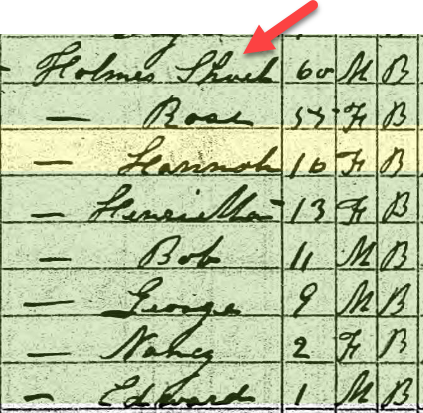
Hannah Holmes’ family in the 1870 census
In this 1870 census record, Hannah’s family was living next to two other Holmes/Holms families. This is likely not a coincidence.
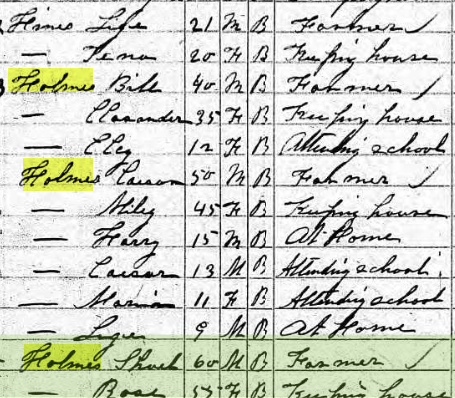
Holmes families in the 1870 Liberty County census
Let’s flip back to the 1880 census, which had Hannah James living on her own with her children.

1880 census with Hannah Holmes
Hannah and her children were living next to the same two Holmes’ families as she and her parents were in the 1870 census. This is a very strong indication that Hannah James was Hannah Holmes. Where were Shael (?) and Rose Holmes in 1880? The only way to find them was to search for Rose because the enumerator apparently had such trouble with Shael’s name that he left it out altogether![4]

Rose and [first name left out] Holmes in the 1880 census.
They were apparently not living near their original neighborhood, or something about the way the enumeration was done made it appear so, at least.
By this point, it appears very likely that Shael and Rose Holmes were Hannah James’ parents and likely that Caesar Holmes and Billy Holmes were either relatives or adopted the Holmes surname for the same reason as Shael and Rose did.
What happened to Hannah’s parents after 1880? Shael appears to have died during that period, as in the 1900 census, Rosa Holmes was living with her son Edward Holmes and was listed as a widow.[5] A Molly James was the head of the household, and Edward was listed as her brother, despite an apparent 31-year age gap. Rosa Holmes was listed as her mother. Something appears to be wrong with the enumeration, as Rose was also listed as only having borne one child. However, this does appear to be them.
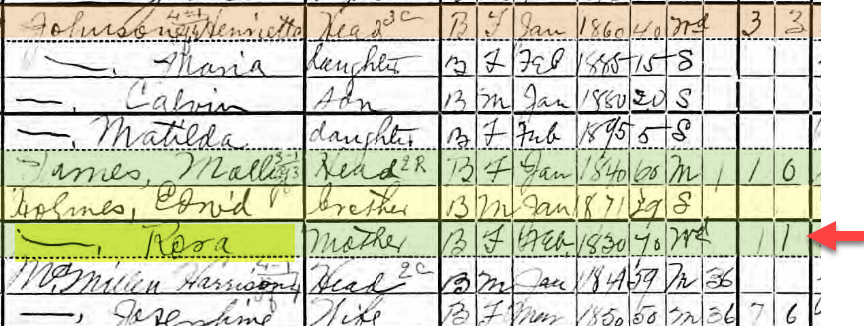
1900 Liberty County census showing Rosa Holmes
During Slavery
To learn more about the Holmes family prior to Emancipation, we must discover who was holding them in slavery. In Liberty County, it was only a minority of freed people who adopted the surname of their last enslaver[6], and there was no white Holmes slaveowner at that time anyway.[7] Many freed people, however, did adopt the surname of an earlier enslaver of their family so the surname they adopted can be an important clue that allows for finding the records needed to bring their ancestors to light.
In this case, Holmes was the surname of an earlier family of enslavers. James Holmes, a merchant, died around 1826 and had an estate inventory performed that year.[8] It listed all of the enslaved people he owned at the time of his death (and any who were born after his death). The value of the 30 people listed in the inventory was assessed at $7800. The entire value of the appraised property, including the enslaved people, was $7970, indicating how valuable the people were.
Listed on that estate inventory was a Sherval. Could this be Shael (or Shuel)? Sherval was a very unusual name, and could have sounded quite different pronounced with a heavy Southern accent. Shael Holmes was found in only two records post-Emancipation;[9] one (the 1870 census) listed his birth year as 1810 and the other (the 1880 census) as 1820. This variation was not at all unusual in census records but leaves us with a wide range of possible birth years. However, in either case, Shael would have been born by the time of the 1826 James Holmes estate inventory.
Rose Holmes has a similar fluctuation: 1815 (1870), 1821 (1880) and 1830 (1900). This leaves open the possibility that she did not appear in the Holmes estate inventory because she had not yet been born, but it could also be that she was not living on that plantation and was held in slavery by someone else.
It seems quite likely that Sherval is Shael, given that he adopted Holmes as a surname upon Emancipation. What else can we find about him in antebellum records?
In those times, planters often had to borrow money to finance their crops, hoping to repay the money with a successful crop. They would often use enslaved people as collateral on their promissory notes, called chattel mortgages.
In 1825, James Holmes made a promissory note to Major Samuel S. Law, and he used “Chevel” as collateral on the note.[10] In all he used 30 enslaved people and a plantation called Bonaventure as collateral on that note. The names were listed in what appeared to be family groups! Chevel was listed in “Yellow Will, Nancy, Lucky [or Sucky], Chevel & Jenny.”

1825 James Holmes promissory note to Samuel S. Law
This likely means Will and Nancy were the parents of the others, and that Chevel was young enough to still be listed with his family, so a birth year around 1810-1820 could fit. Holmes made this mortgage to Law because Law had co-signed a note to the Bank of Darien and Law wanted to make sure that he would not lose money if Holmes defaulted.
If these are indeed family groups, and there is no reason to think they are not, then we appear to have found Shael’s parents: Will and Nancy [or Nanny]. This is a remarkable and unusual find.
James Holmes must have been heavily in debt when he died, because in the couple of years after that estate inventory, most of the people listed in it were seized by various banks. Sherval, now spelled something like Sherwill or Shuwell, and others, were sold by the Bank of Darien to Charlton Hines in 1828 after the bank bought them at a Sheriff’s sale in 1827.[11]

1826 sale of Shuwell by the Bank of Darien
Note the other names in this bill of sale: Billy, Caesar and Josephine. Billy Holmes and Caesar Holmes were living next to the Shael Holmes family in the census records. A Josephine McMillen was living next to Rosa Holmes.
Other people were sold to the Bank of the State of Georgia and to the Planters Bank in 1826.[12]
Charlton Hines, to whom Shuwell was sold, was a wealthy and long-lived land- and slave-owner in Liberty County. The county seat, Hinesville, was named for his family. He died right in the last full year of the Civil War, in 1864, and because of this, his estate inventory named enslaved people, which it would not have done if he had died the following year.
The estate inventory was performed in May 1864, and there were 136 enslaved people listed by name and appraised value in it.[13] Particular care has to be taken with these large estate inventories to examine them carefully in connection with other documents before drawing conclusions, but in this case the conclusion was obvious. Shuell and Rose were listed next to each other. Shuell, as we have seen, is a very unusual name, and the juxtaposition with Rose makes it impossible to imagine that these are not the Shuell and Rose who adopted the name Holmes and were found in the 1870 census.

1864 Charlton Hines estate inventory naming Shuell and Rose
If we go back to the 1870 census that listed Caesar Holmes and Billy Holmes next to Shuell and Rose, we see that Caesar’s wife’s name was Miley:
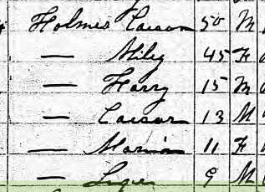
1870 census naming Caesar and Miley Holmes
In the 1864 Charlton Hines estate inventory, we find:

1864 Charlton Hines estate inventory
And perhaps most interesting of all, we find Billy Holmes — with that surname! — in the 1864 estate inventory:

1864 Charlton Hines estate inventory
Here is Billy Holmes in the 1870 census:

1870 Liberty County census showing Bill Holmes
It seems very likely that the people sold from the Holmes estate to Charlton Hines were known informally by the Holmes surname to distinguish them from people of the same first name, and probably by themselves to recall their family lineage. Using the knowledge that freed people in Liberty County rarely adopted the surname of the last enslaver, and the developing evidence that the surname they did adopt often seems to have come from an earlier enslaver of their family, we have been able to trace Elisha James’ great-grandparents back into slavery times.
Future research into James Holmes, his family relationships, and his slavery transactions may be able to push this window back even further. Unfortunately, this is often a question of luck: were there events in the enslaver’s life that produced documents (wills, estate inventories, deeds of sale, chattel mortgages, etc)?
SOURCES
-
1880 U.S. Census, Liberty County, Georgia, population schedule, District 15, enumeration district 67, page 67, dwelling 233, family 234, entry for Hannah James household; digital image, Ancestry (https://www.ancestry.com/imageviewer/collections/6742/images/4240148-00422: accessed 28 May 2023, image 22 of 84). ↑
-
“Georgia, Death Index, 1914-1940,” entry for Elijah James, McIntosh, Liberty County, August 30, 1934, State File 24454; database images, Ancestry (https://www.ancestry.com/imageviewer/collections/2562/images/004554611_00206: accessed 28 May 2023), image 206 of 594; citing Family History Library microfilm 004554611. ↑
-
1870 U.S. census, Liberty County, Georgia, population schedule, Subdivision 176, page 23, dwelling 154, family 155, enumerated on November 19, 1870, by John E. Martin, entry for Shael and Rose Holmes household; digital image, Ancestry (https://www.ancestry.com/imageviewer/collections/7163/images/4263491_00311 : accessed 28 May 2023). ↑
-
1880 U.S. Census, Liberty County, Georgia, population schedule, District 17, enumeration district 67, page 78, dwelling 835, family 841, entry for Holms household; digital image, Ancestry (https://www.ancestry.com/imageviewer/collections/6742/images/4240148-00478: accessed 28 May 2023). ↑
-
1900 U.S. Census, Liberty County, Georgia, population schedule, Militia District 1476, enumeration district 88, sheet 7, line numbers 61-63; digital image, Ancestry (https://www.ancestry.com/imageviewer/collections/7602/images/4120072_00108: accessed 28 May 2023). ↑
-
Conclusion based on the author’s research into slavery records of Liberty County (see theyhadnames.net). ↑
-
Based on searches of the 1860 federal population and slave schedules for Liberty County. ↑
-
“Georgia Probate Records, 1742-1990,” database with images, FamilySearch (https://familysearch.org/ark:/61903/3:1:3QS7-L93L-P6P?cc=1999178&wc=9SYT-PT5%3A267679901%2C268032901 :28 May 2023), Liberty > Wills, appraisements and bonds 1790-1850 vol B > image 451 of 689. ↑
-
Shael Holmes does not appear to have registered to vote after the Civil War. The Liberty County voter’s registration list was scanned line-by-line, given the possibility of mistranscription of his unusual name, and no one close to that name was found. ↑
-
Liberty County Superior Court “Deeds and mortgages, 1777-1920; general index to deeds and mortgages, 1777-1958,” Film: Deeds & Mortgages, v. H-I 1816-1831,” Record Book I, 1822-1831, p. 139-40. Image #371-2; digital images, Family Search.org (Link: https://www.familysearch.org/ark:/61903/3:1:3Q9M-CS42-SSBR-5 : accessed 28 May 2023). ↑
-
Liberty County Superior Court “Deeds and mortgages, 1777-1920; general index to deeds and mortgages, 1777-1958,” Film: Deeds & Mortgages, v. H-I 1816-1831,” Record Book I, 1822-1831, p. 286. Image #451; digital images, Family Search.org. (https://www.familysearch.org/ark:/61903/3:1:3Q9M-CS42-SSYK-2?i=450&cat=292358 : accessed 28 May 2023). For an abstract of this record, see: https://theyhadnames.net/2021/09/12/bill-of-sale-holmes-hines/. ↑
-
Planters Bank: Liberty County Superior Court “Deeds and mortgages, 1777-1920; general index to deeds and mortgages, 1777-1958,” Film: Deeds & Mortgages, v. H-I 1816-1831,” Record Book I, 1822-1831, p. 247. Image #431; digital images, FamilySearch.org (https://www.familysearch.org/ark:/61903/3:1:3Q9M-CS42-SSY1-X : accessed 28 May 2023). Bank of the State of Georgia: Liberty County Superior Court “Deeds and mortgages, 1777-1920; general index to deeds and mortgages, 1777-1958,” Film: Deeds & Mortgages, v. H-I 1816-1831,” Record Book I, 1822-1831, p. 242. Image #429; digital images, Family Search.org. (https://www.familysearch.org/ark:/61903/3:1:3Q9M-CS42-SSB9-3 : accessed 28 May 2023). ↑
-
“Georgia Probate Records, 1742-1990,” database with images, FamilySearch (https://familysearch.org/ark:/61903/3:1:3QS7-L93L-RJ96?cc=1999178&wc=9SYY-ZNP%3A267679901%2C268025701 : 20 May 2014), Liberty > Wills 1863-1942 vol C-D > image 43 of 430. For an abstract of this inventory, see https://theyhadnames.net/2019/03/18/liberty-county-estate-inventory-charlton-hines/. ↑